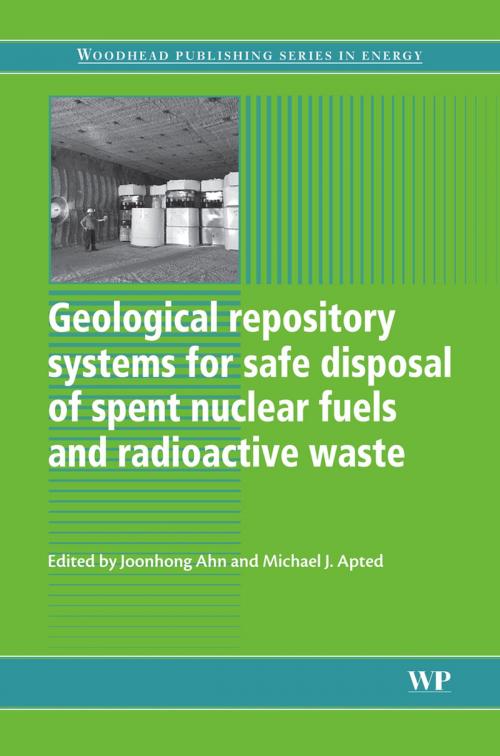Geological Repository Systems for Safe Disposal of Spent Nuclear Fuels and Radioactive Waste
Nonfiction, Science & Nature, Technology, Engineering, Environmental| Author: | ISBN: | 9781845699789 | |
| Publisher: | Elsevier Science | Publication: | July 27, 2010 |
| Imprint: | Woodhead Publishing | Language: | English |
| Author: | |
| ISBN: | 9781845699789 |
| Publisher: | Elsevier Science |
| Publication: | July 27, 2010 |
| Imprint: | Woodhead Publishing |
| Language: | English |
Geological disposal has been internationally adopted as the most effective approach to assure the long-term, safe disposition of the used nuclear fuels and radioactive waste materials produced from nuclear power generation, nuclear weapons programs, medical, treatments, and industrial applications. Geological repository systems take advantage of natural geological barriers augmented with engineered barrier systems to isolate these radioactive materials from the environment and from future populations.
Geological repository systems for safe disposal of spent nuclear fuels and radioactive waste critically reviews the state-of-the-art technologies, scientific methods, regulatory developments, and social engagement approaches directly related to the implementation of geological repository systems.
Part one introduces geological disposal, including multiple-barrier geological repositories, as well as reviewing the impact of nuclear fuel recycling practices and underground research laboratory activities on the development of disposal concepts. Part two reviews geological repository siting in different host rocks, including long-term stability analysis and radionuclide transport modelling. Reviews of the range of engineered barrier systems, including waste immobilisation technologies, container materials, low pH concretes, clay-based buffer and backfill materials, and barrier performance are presented in Part three. Part four examines total system performance assessment and safety analyses for deep geological and near-surface disposal, with coverage of uncertainty analysis, use of expert judgement for decision making, and development and use of knowledge management systems. Finally, Part five covers regulatory and social approaches for the establishment of geological disposal programs, from the development of radiation standards and risk-informed, performance-based regulations, to environmental monitoring and social engagement in the siting and operation of repositories.
With its distinguished international team of contributors, Geological repository systems for safe disposal of spent nuclear fuels and radioactive waste is a standard reference for all nuclear waste management and geological repository professionals and researchers.
- Critically reviews the state-of-the-art technologies, scientific methods, regulatory developments, and social engagement approaches related to the implementation of geological repository systems
- Chapters introduce geological disposal and review the development of disposal concepts
- Examines long-term stability analysis, the range of engineered barrier systems and barrier performance
Geological disposal has been internationally adopted as the most effective approach to assure the long-term, safe disposition of the used nuclear fuels and radioactive waste materials produced from nuclear power generation, nuclear weapons programs, medical, treatments, and industrial applications. Geological repository systems take advantage of natural geological barriers augmented with engineered barrier systems to isolate these radioactive materials from the environment and from future populations.
Geological repository systems for safe disposal of spent nuclear fuels and radioactive waste critically reviews the state-of-the-art technologies, scientific methods, regulatory developments, and social engagement approaches directly related to the implementation of geological repository systems.
Part one introduces geological disposal, including multiple-barrier geological repositories, as well as reviewing the impact of nuclear fuel recycling practices and underground research laboratory activities on the development of disposal concepts. Part two reviews geological repository siting in different host rocks, including long-term stability analysis and radionuclide transport modelling. Reviews of the range of engineered barrier systems, including waste immobilisation technologies, container materials, low pH concretes, clay-based buffer and backfill materials, and barrier performance are presented in Part three. Part four examines total system performance assessment and safety analyses for deep geological and near-surface disposal, with coverage of uncertainty analysis, use of expert judgement for decision making, and development and use of knowledge management systems. Finally, Part five covers regulatory and social approaches for the establishment of geological disposal programs, from the development of radiation standards and risk-informed, performance-based regulations, to environmental monitoring and social engagement in the siting and operation of repositories.
With its distinguished international team of contributors, Geological repository systems for safe disposal of spent nuclear fuels and radioactive waste is a standard reference for all nuclear waste management and geological repository professionals and researchers.
- Critically reviews the state-of-the-art technologies, scientific methods, regulatory developments, and social engagement approaches related to the implementation of geological repository systems
- Chapters introduce geological disposal and review the development of disposal concepts
- Examines long-term stability analysis, the range of engineered barrier systems and barrier performance















